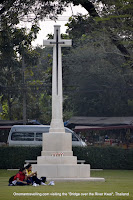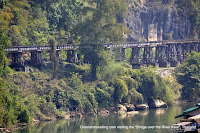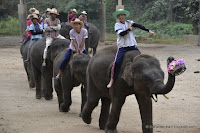Bridge over the River Kwai

Yesterday, due to Covid19 parades and gatherings not being permitted. a select few laid a wreath at the local war memorial commemorating the 75th anniversary of victory over Japan, the end of WWII. Contemplating this event on Sunday I thought that I would brush off the metaphorical dust from a photo album recorded during my visit to Thailand and update my blog. The event was a train journey over the "Bridge over the river Kwai", and visits to the museum and war graves there on 28th January 2015. The memorial shown is located in the Kanchanaburi War Graves Cemetery, Thailand. Hayling Island has a similar monument near St Mary's Church.
I had completed my journey around the country and returned to Bangkok but was determined to visit this location before flying back to South Africa. I will fill in the gaps later perhaps completing all of my blogs (don't hold your breath!). Three trains a day make the journey from Kanchanaburi over the bridge up to Tham Krasae Bridge. This affords a view of the bridge, the line constructed through the jungle and one of the many tresses constructed along the side of the cliffs to accommodate the track. The line went on up into Burma, now Myanmar, now terminates at Nam Tok. There is little left on the other side of the border. wikipedia.org - Burma Railway describes the route, construction and death toll of this infamous railway.
The Thai people are friendly and helpful this is actually a very pleasant journey through stunning countryside, the trains and carriages haven't changed much over the years nor has the way of life. Farmers still plough and grow, cattle and oxen plod along much as life must have gone on all those years ago. It is poignant to think of sick and starving men constructing this route perhaps stopping once in a while to raise their heads and remark at the paradise around them. Many locals suffered at the hands of the Japanese army too.
I took several photos of the line being replaced by heavy duty engineering with meagre crews in contrast to between 180,000 and 250,000 allied prisoners of war. Imagine the weight of those teak logs felled, cut and laid as sleepers. The manhandling of tons of iron to build bridges and lay track. No canteen break, a bowl of rice a day. The journey is a contrast between the huge metal bridge over the river and the long trestles constructed to carry the line along the sides of gorges. No wonder so many, about 16,000, died in the process and those who lived did not want to tell the tale.
I didn't go to the end of the line, time did not permit but I think, as the photographs show, that I captured the essence of the place. It was a fine day, not too hot though the temperature can rise considerably and it becomes very humid too. Tropical downpours are a regular occurrence. I had lunch at a very pleasant resort restaurant which afforded stunning views of the river, surrounding countryside and the massive trestle bridge which carries the line around the gorge.
A large cave behind this structure now houses a shrine where, during the construction, Japanese guards billeted. Later, visiting the museum back at Kanchanaburi I would see examples of the rough huts and small railway wagons housing the allied prisoners of war. No wonder that disease was rife. It is hard to reconcile my experience with those brave men and women who were held captive and prompted my visit and this post today. Exhibits in the museum also reflect other wars which intruded upon the peace of the nation.
My final destination as the sun began to set was to the Kanchanaburi War Graves where those who died in the construction of the railway in this area are gathered and remembered. It is a peaceful place laid out in rows with fresh flowers and green, green grass of home. I bowed my head and reflected. Wandering around I could not record all the graves but picked a sample of the various regiments and ranks. This was not an individual regiment but a whole army in the field brought low.
Please view the the area through my photo album Bridge over the River Kwai, despite the sombre overtones for some it is a beautiful place to visit. I was amused when we arrived back, the train stopped on the bridge and lots of people were climbing along the structure. I am of the opinion that the bridge is used by pedestrians when trains aren't scheduled. We halted for about 15-20 minutes before pulling into the station. A wedding had been taking place at the station plaza!










Another excellent blog Arthur. Very descriptive and informative. The cruelty suffered at the hands of the Japanese should never be forgotten.
ReplyDelete